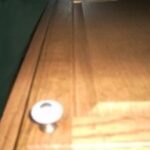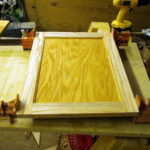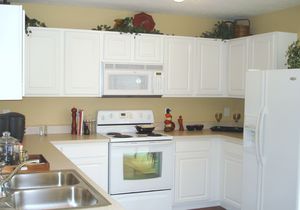Choose a type of wood that corresponds with your vision. Are you looking for a clear varnish over a darker wood, a darker varnish over a natural light wood or a clear varnish over a light wood, preserving it’s color.
Start with the basic rectangular pieces of wood that you will be using to replace your doors with. Measure the L x W of the cabinet opening for good measure. You do want your doors to close around the opening however. How thick a perimeter to leave around the opening of the cabinet is up to you. The bottom edge of the door can be brought down to the base of the cabinet, or just to peek over the inside rim of the cabinet about 1. Architecturally, when you have decided on the design, take the measurements of your final decision and cut all doors with a corresponding cabinet size to the same size as your “template” door. Don’t forget to put into account the measurements of different sized cabinetry.
When the cabinets are cut, I would say it is imperative to bevel the fronts of the cabinets unless you are going for a stark and sleek look about your kitchen. If the rest of your kitchen is decorative and there is no beveling on the cabinet doors, it will just look boring and out of place. This would be the case unless of course you are building cabinet doors out of precut materials and glass and you are just assembling the pieces and the glass, then attaching them to your cabinets with hinges.
After the beveling is done comes the process of staining or varnishing your cabinet doors. Use a paintbrush and do this in a well ventilated area, preferably outside. Try not to breathe in the harsh chemicals. Stain the front side and allow the appropriate time for the stain to dry. You may choose to stain the back side of the cabinets, though it is not quite necessary.
After your doors have been beveled in a nice design, and stained to their perfect color, you may choose to pick out the proper hardware for the color scheme that you have chosen. The handles and the hinges should be of corresponding types of metal, unless of course the handles you choose are an enamel or glass type.
Measure where you want the handles to go with a tape measure, and mark the same measurement on every door. Drill a hole through the door with a drill bit in a corresponding size to the door handle if it is the type of handle that goes directly through to the other side. Otherwise, use an electric drill to screw in the small screws which will accompany the handles. Have an extra hand with you to help hold the doors in place and pass you necessary tools during this process. Here is a diagram I have found online demonstrating the proper assemblage of the doors and hinges. Once the hinges are attached to the cabinet, and the door, you should have a fully functioning beautiful cabinet made by you.




